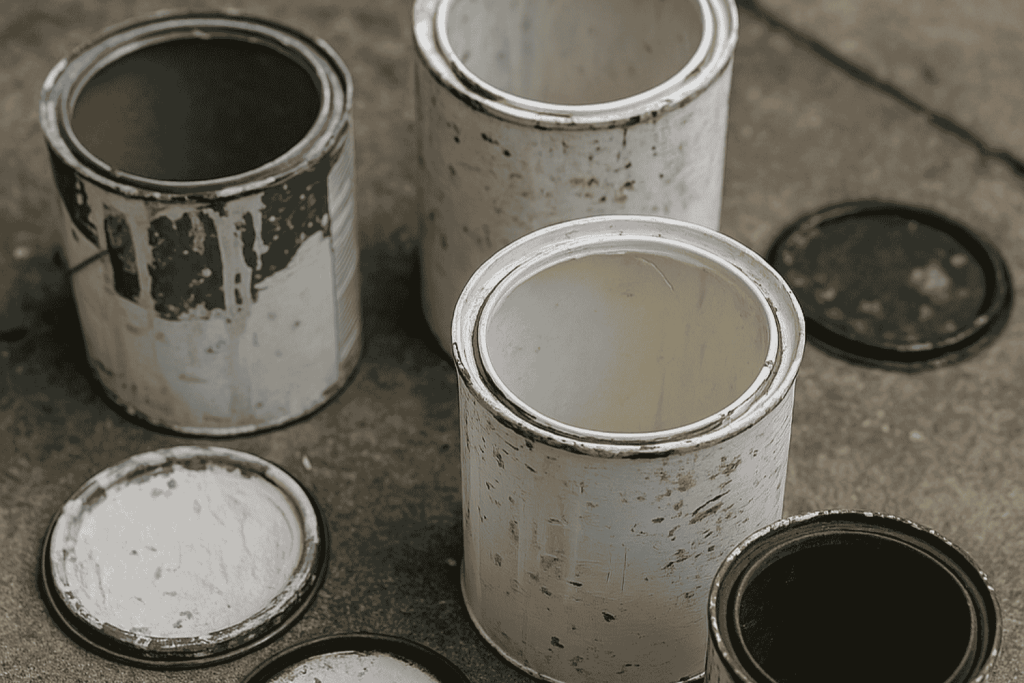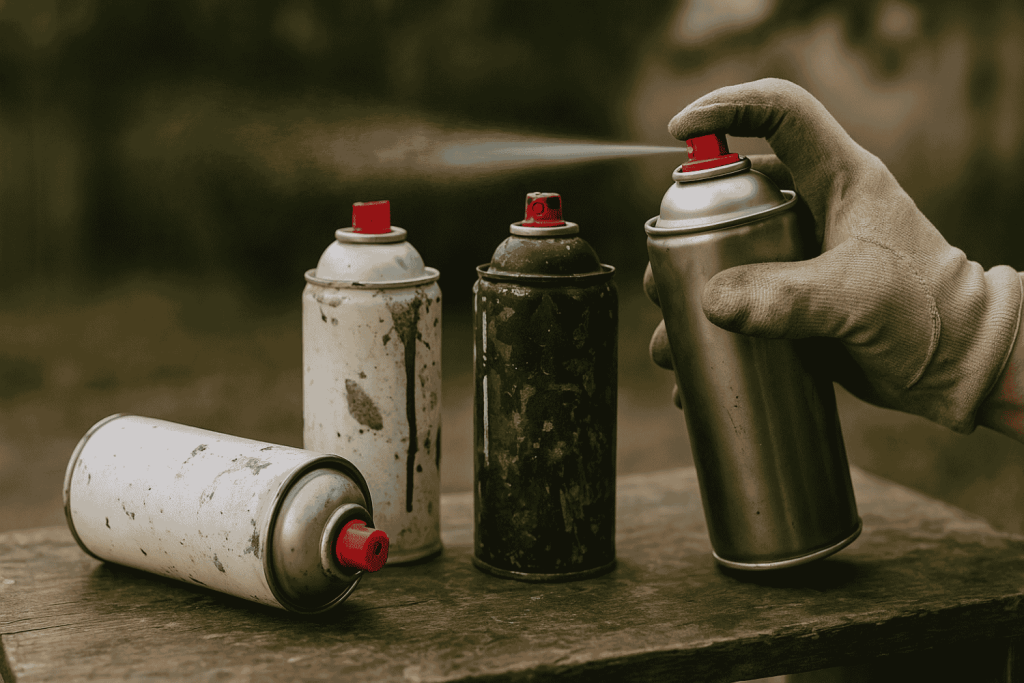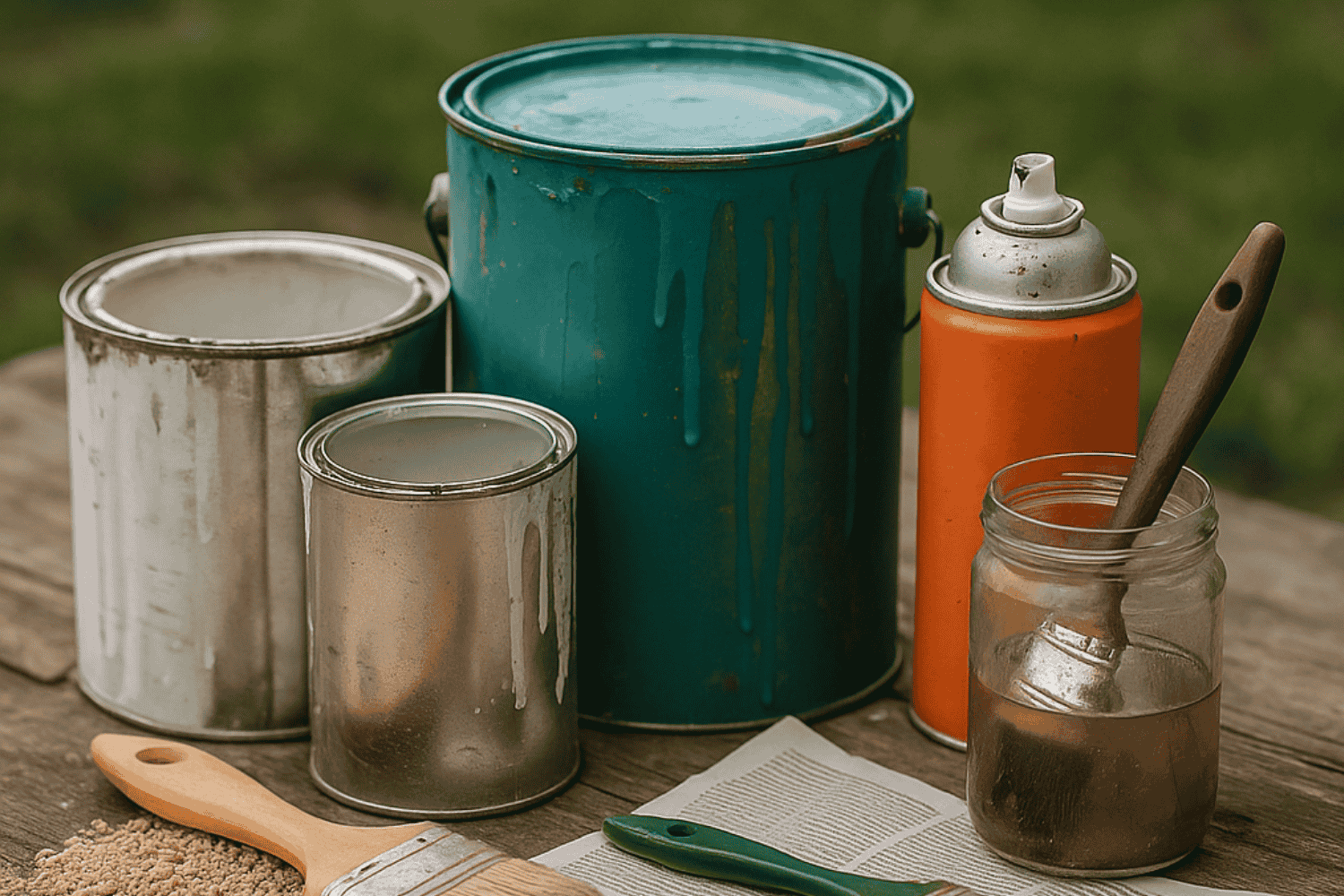Each year, Americans throw away an estimated 64 million gallons of leftover paint, much of it improperly.
When paint is poured down drains, tossed in the trash, or left to seep into the ground, it introduces harmful toxins like volatile organic compounds (VOCs) and heavy metals into our environment.
These pollutants contaminate soil, poison water sources, and contribute to air pollution, posing serious risks to both ecosystems and human health.
Understanding how to dispose of paint responsibly isn’t just a matter of legal compliance; it’s a crucial step toward protecting our planet.
Whether you’re clearing out your garage or wrapping up a home improvement project, it’s essential to know the right way to handle leftover or expired paint.
At Earth Paint Collective, our environmental professionals emphasize that paint should be treated as a potential pollutant, not ordinary trash.
This comprehensive guide will walk you through everything you need to know, including:
- The dangers of improper paint disposal and how it affects soil, water, and air.
- How to identify different paint types and why each requires a unique disposal method.
- Step-by-step instructions for disposing of latex, oil-based, acrylic, spray paint, and solvents.
- Legal and environmental regulations you need to follow to avoid fines and reduce pollution.
- Sustainable practices to minimize leftover paint and reduce waste in the future.
By the end of this article, you’ll be equipped with the knowledge to responsibly dispose of any kind of paint you might encounter, safeguarding your community, complying with environmental laws, and contributing to a cleaner, healthier planet.
How To Dispose of Old Paint
When it comes to leftover or expired paint, the first step is determining whether it’s still usable or if it’s time to discard it.
At Earth Paint Collective, we often see perfectly good paint thrown away simply because people aren’t sure how to assess its condition. Understanding how to store paint properly and recognize when it has gone bad can help reduce waste and protect the environment.
Storage and Shelf Life
- Store paint in a cool, dry place away from direct sunlight or extreme temperatures.
- Seal the lid tightly after each use. For a tighter seal, place plastic wrap over the opening before hammering the lid down.
- Label the can with the date of purchase and the room or project it was used for.
*A good indicator that paint is still usable is a smooth consistency after stirring. If it blends well and smells like typical paint, it’s likely still fine.
When To Dispose
- Separation: If the paint has separated into layers and won’t mix back together, it’s no longer usable.
- Foul odor: A sour or rancid smell is a sign of bacterial growth, especially in latex paint.
- Mold or clumps: If you see mold or thick chunks that don’t stir out, it’s time to let it go.
Once you’ve determined that paint is no longer usable, it’s important to dispose of it responsibly, not by pouring it down the drain or tossing it in the trash in liquid form.
General Disposal Options
- Donate it: Many community centers, schools, theaters, or nonprofits will accept usable leftover paint.
- Reuse it: Save leftover paint for touch-ups or smaller projects. Combine similar colors to make a base coat or primer.
- Solidify it: If the paint is unusable, mix it with cat litter, sawdust, or commercial paint hardener. Once it’s fully dry, it can usually be placed in household trash (check local guidelines).
How To Dispose of Paint Cans

Empty Paint Cans
- Let any residual paint dry completely.
- Leave the lid off so waste collectors can verify the can is dry.
- Recycle the metal can if your local recycling program accepts them—most do.
Partially Full Cans
- Dry it out: Use drying techniques (covered in the latex section below).
- Hazardous waste: If the paint is oil-based or solvent-heavy, take the can to a Household Hazardous Waste (HHW) collection event.
Label and Lid Removal
- The lid must be removed (to confirm the paint is dry).
- The original label should remain on the can (to identify paint type).
Always check your local waste disposal guidelines for specific instructions.
How To Dispose of Paint Thinner
Storage and Reuse
- Pour used thinner into a clear, sealable container.
- Let it sit for several days until solids sink to the bottom.
- Carefully pour off the clear liquid into a clean container for reuse.
- Label both containers clearly.
Hazardous Waste Collection
- Take it to a certified HHW facility or designated drop-off event.
- Transport in a sealed, labeled container, and follow local guidelines.
Never Down the Drain
- It can contaminate water supplies and harm aquatic life.
- It may damage plumbing systems and septic tanks.
- It could cause dangerous vapor buildup.
How To Dispose of Latex Paint
Drying Techniques
- Mix with an absorbent like cat litter, sawdust, or shredded paper.
- Use commercial paint hardeners available at hardware stores.
- Leave the lid off and allow small amounts to air dry in a well-ventilated area.
Small vs. Large Quantities
- Small amounts: Solidify in the can and dispose of with household trash (with lid off).
- Large quantities: Pour into a lined cardboard box in thin layers, allowing each to dry before adding more.
Household Trash Guidelines
- Once latex paint is dry and hardened, it is no longer considered hazardous waste.
- Dispose of it in regular trash with the lid off.
Always confirm with your local waste authority.
How To Dispose of Spray Paint

Empty vs. Non-Empty Cans
- Empty cans: Completely depressurized cans can go in regular trash or recycling, depending on local rules.
- Partially full cans: Must be treated as hazardous waste and brought to an HHW collection event.
Safety Precautions
- Spray until the can is empty in a well-ventilated area.
- Keep away from open flames or high heat to avoid explosion.
- Wear gloves and a mask when handling spray paint.
Local Disposal Events
Many municipalities host HHW collection events where you can safely dispose of aerosol products. Check with your local public works department.
How To Dispose of Acrylic Paint
Non-Toxic but Not Harmless
- Enter waterways and harm aquatic organisms.
- Contribute to microplastic pollution in ecosystems.
Solidification and Disposal
- Let small amounts dry out on a palette or in a container.
- Once hardened, dispose of in household trash.
Cleanup and Brush Washing
- Wipe excess paint onto newspaper or rags.
- Rinse in a bucket, let water settle, and dispose of solids in the trash.
How To Dispose of Oil Based Paint
Identifying Oil-Based Paint
- Look for “alkyd” or “oil-based” on the label.
- Oil-based paints come with instructions to clean with mineral spirits or turpentine.
HHW Collection Events
Because of the VOCs and heavy metals it contains, oil-based paint must be taken to a certified HHW facility. Never pour it down the drain or throw it in the trash.
Health and Environmental Risks
- Soil and water contamination
- Air pollution via VOCs, contributing to smog and respiratory issues
- Harm to wildlife and long-term ecological damage
Legal and Environmental Considerations
Household Hazardous Waste (HHW) Classification
- Oil-based paints
- Paint thinners and solvents
- Non-empty spray paint cans
Local Laws and Fines
- Civil penalties or fines
- Increased cleanup costs for municipalities
- Potential criminal charges in severe cases
Environmental Hazards
- Leach toxins into soil and groundwater
- Emit VOCs contributing to air pollution
- Harm wildlife through ingestion or habitat contamination
Sustainable Practices To Reduce Paint Waste
Buy Only What You Need
Use paint calculators or consult experts to estimate how much paint your project requires. This reduces leftovers and saves money.
Choose Low-VOC Paints
Low-VOC paints help avoid:
- Indoor air pollution
- Smog formation
- Health risks for painters and residents
Support Recycling Programs
- Donate to reuse stores like Habitat for Humanity ReStore
- Participate in local recycling days or HHW events
In Summary
Properly disposing of paint is more than just a household chore; it’s an environmental responsibility. Whether you’re dealing with latex, oil-based, acrylic, spray paint, or thinners, identifying the type of paint and following the correct disposal method is critical.
As we’ve explored, each paint type carries unique environmental and legal implications, from VOC emissions and soil contamination to hefty penalties for improper disposal.
By applying the best practices outlined in this guide, from solidifying latex paint to taking oil-based products to certified HHW facilities, you’re actively protecting your health, your community, and the planet.
At Earth Paint Collective, our team of environmental professionals encourages you to think sustainably from the moment you purchase paint.
Buying only what you need, choosing low-VOC options, and participating in local recycling programs can dramatically reduce leftover waste. Never pour paint down the drain or throw it in the trash without proper preparation; it’s hazardous and illegal in many areas.

